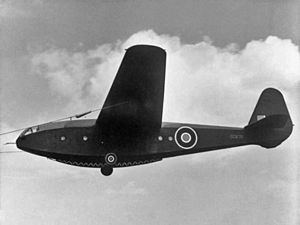Wingspan 24 m Retired 1946 Manufacturer Slingsby Aviation | Length 17 m First flight January 1942 Designer John Carver Meadows Frost | |
 | ||
The Slingsby Hengist was a British military glider designed and built by Slingsby Sailplanes Ltd. Like other British troop carrying gliders in the Second World War, it was named after military figures whose name began with H, in this case the Jute invader Hengist.
Contents
Design and development
The use of assault gliders by the British was prompted by the use by Germany of the DFS 230 transport glider, which was first used in May 1940 to successfully land assault troops on the Eben Emael fort in Belgium. Their advantage compared to parachute assault was that the troops landed in one place, rather than being dispersed.
The Slingsby T.18 Hengist was designed by John "Jack" Frost. It was a 15-seat glider designed to meet Specification X.25/40 (in accordance to O.R.98), issued in February 1941. The specification was issued in case sufficiently powerful tugs were not available for the larger Airspeed Horsa. Four prototypes were ordered in late 1940, the first prototype DG570 flying in January 1942, towed by an Armstrong Whitworth Whitley.
A total of 14 production Hengist Mk I were delivered to the RAF between February 1943 and March 1944. One of Frost's uniquedesign touches was to fit the Hengist with a rubber bag as a landing device. A strengthened undercarriage was used on the production aircraft and was designated the Mk III, but this designation was not carried over to the RAF.
The Hengist had a distinctive appearance with curved upper and lower surfaces and a flat sided fuselage.
Operational history
Two Hengist Mk Is were delivered to the Glider Pilots' Exercise Unit while others were issued to experimental units or remained in storage. Production was halted when Waco Hadrian gliders became available under lease-lend arrangements. As a back-up type, it saw no operational service and was phased out of service in 1946.
Specifications (Hengist Mk I)
Data from Slingsby Sailplanes, British Gliders and Sailplanes 1922-1970
General characteristics
Performance
